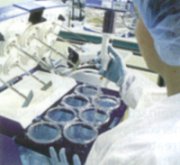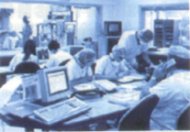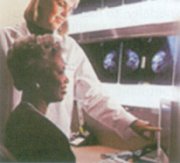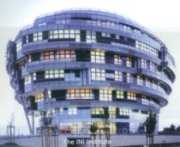
Five Hospital Cancer Treatment Centres at the very top (icon, 2005)
There’s ongoing publicity in the UK about the "postcode lottery" for cancer treatment - where geography dictates who receives the optimum care and who falls short.
It’s shocking to think that location may be as important a factor in cancer treatment as in buying a house. But given increasing cancer awareness and patient choice, perhaps you’re not confined to consultations in a hospital near home. Go, if possible, to the gold standard. As travel not only broadens the mind but could save your life, we highlight five cancer centres of excellence, one in the UK and four abroad. They are not cancer clinics, more Hospitals at the very top as cancer treatment centres.

Institut Gustave Roussy
39 Rue Camille
Desmoulins, 94805
Villejuif. Paris.
Tel: 0033 1 4211 4211
Website: http://www.igr.fr
Special Features
Paris has two fine cancer hospitals but the lnstitut Gustave Roussy (IGR) in suburban Villejuif is styled Europe’s first Centre of Cancer Prevention. lndicative of the ICR’s premier status is its prestigious new partnership to pool medical and research information with the MD Anderson Cancer Centre in Houston, Texas (see later).
This three-year co-operative venture - starting this year and the first of its kind in Europe - involves exchange of staff, current shared trials on the treatments of high-risk testicular cancer patients and planned projects in lung and thyroid cancers. The two hospitals will also be sharing bioiogical research material on tumour characteristics and responses to tumour-specific treatments. Thirty three million euros of the hospital’s total 178m euros goes to research, and passing knowledge on to other French cancer centres is an ICR priority. Besides drugs and genetics, CR has a special research mission in high-potential therapies of the future - cell therapy, gene therapy, immunology and immunotherapy and vectorology (using viruses to implement gene therapy).
The hospital sets great store by minimally invasive surgery that also preserves quality of life. Radio-guided surgery has been advanced by close co-operation between surgeons and the isotope service. Currently used in surgery for breast cancer, thyroid cancer and melanoma, this technique enables a sample to be take from the "sentinel" lymph node (the one most likely to be affected). If this proves normal, no further nodes need be removed. In rectal cancer surgery the chances of preserving the anal sphincter are very high and artificial sphincters are also possible.
Amputation is still the regular prognosis for limb sarcomas, but The IGR is the only centre in France to use a "perfusion" technique with out of body circulation so that the tumour can be reduced, then making an incision possible so that the limb can be saved.
Facts and figures
The ICR is a non-profit making hospital and research centre exclusively devoted to oncology. Privately run, but state approved, it has a 2,350 strong staff including 124 physicians, and 400 research scientists. Close communication between researchers and doctors is a given, so that new discoveries are applied clinically as quickly as possible.

The ICR is a non-profit making hospital and research centre exclusively devoted to oncology

There’s a School of Oncology linked to the University of Paris. The hospital has 400 beds, sees 11,500 new patients a year, treats between 42,000 and 149,000 outpatients. Treatment is free for French and European patients with Social Security cover. More than half ICR’s patients are from the Paris area, 32 per cent from the rest of France and nine per cent from abroad. The most common cancer conditions seen at ICR are breast (21.3 per cent) head and neck, (10.5 per cent) skin, gastro-intestinal and gynaecological (each 10 per cent) and urogenital (nine per cent).
The latest in radiotherapy, brachytherapy, medical imaging and nuclear medicine facilities mean patients always receive what’s needed under the very roof they were diagnosed.
Patient package
"From research to recovery is ICR’s motto and excellence, innovation and evaluation its guiding principles. The hospitals philosophy is to treat patients increasingly like partners who take an informed part in therapeutic decisions, rather than submitting meekly to prescribed treatment. Nutrition and pain control are high on the patient care agenda, children have their own art studio and there’s a parents’ house (albeit sponsored by fast food outlet McDonald’s) to ensure families of sick children can stay together. The hospital has a designated researcher into complementary therapies and offers on-site kinesiology. There’s free beauty treatment and a hairdresser; day patients on social security can have free accommodation at a nearby hotel and other patients receive preferential rates.

Istituto Nazienale dei Tumori di Milan
Via Venezian. MiIano
Tel: 0039 2 23901
Website: http://www.istitutotumori.mi.it
Special features
Only one per cent of patients admitted to the lstituto Nazionale dei Tumori di Milano (INT) comes from abroad, suggesting that this medically meticulous, yet visionary cancer centre is still a well-kept secret. Perhaps not for long because Scientific Director Dott. Natale Cascinelli has already carved out the INT’s pride of place in the vanguard of genetic research. As the human genome project nears conclusion the NT has set itself the "Titanic enterprise" of identifying the function of every individual gene among 40,000, and of perhaps millions of proteins, their various mechanisms and interactions and the possible mutations that can lead to cancer. Recognising that traditional analysis and calculation would be totally defeated by this complex data-processing, the INT is already pushing forward the boundaries of bio-information technology. Another key venture planned is the creation of a bank for biological materials, ensuring that the INT’s 191 research biologists, chemists and physicists have all the research matter they could require.
The INT’s existing renown for scientific research is borne out by its choice as guiding light of Eurochip, an ongoing EU study into national variations in the prevention, early diagnosis and treatment of cancer. As INT Director of Epidemiology, Dott. Andrea Micheli has already filed his findings on Eurochip Phase 1 - the identification of 26 high priority cancer prevention indicators. It reflects highly on his hospital that Dott Micheli remains in charge of Phase 2 - the only oncology study that the EU’s public health commission has funded this year. Phase 2 is entitled "For Action" and its goal is to identify the most effective cancer-busting strategies for individual member states. "For some countries" says Dott. Micheli "the emphasis could turn out to lie in preventive measures, whereas in others it may be a case of improving therapies."
Facts and figures
The lstitutos motto is "Alliance against cancer". It avows "complete respect for human life from the moment of birth to death" and lists keeping the public up to date with cancer issues as one of three prime research objectives, along with the improvement of diagnostics and treatment and the further understanding of biological mechanisms. The lstituto has 418 rooms, mostly two-bedded, though some have three or four En-suite single rooms on the eighth floor private wing also have a spare bed for relatives. The day hospital has another 54 beds and eight operating theatres.

High quality, high-tech equipment includes four scanners and a PET scanner with attached cyclotron

High quality, high-tech equipment includes four scanners and a PET scanner with attached cyclotron. Cobalt therapy facilities and four linear accelerators are available, one with beam-modulated intensity which can be used for stereotactic surgery. The INT has 243 physicians, 10 doctors on bursaries, 100 biologists, chemists and physicists with a further 91 on bursaries, five psychologists, 411 nurses (that’s almost one per room) and 229 technciains. Last year 13,203 patients were admitted, 11,121 operations were performed, 13,805 day hospital patients were seen whilst outpatient consultations and tests numbered more than 800,000. Sixty per cent of patients came from local Lombardy and 39 per cent from other areas of Italy.
One woman with breast cancer and a second whose liver tumour was treated with surgery and a slow-release chemo implant had particularly high praise for the NT’s after care.
Patient package
Liver cancer care is a specialty; to mark its 75th anniversary in 2003, the lstituto opened a new facility for abdominal surgery, specialising in liver transplant. Five years ago the American Liver Study Group recognised INT’s excellence when it adopted the "Milan Criteria" as its standard prognosis for liver transplantation. So far over 200 patients have been transplanted at the INT’s Via Venezian unit and recent data compiled by Italy’s National Transplant Centre, found INT’s patient survival in this field to be the best in the country. Last year, patients keen to try innovative research treatments took part in 102 clinical studies. The INT played a strong role in the testing of the smart drug Gleevac for leukaemias and rare stomach tumours among other cancers. Dott Natale Cascinelli designed the WHO’s collaborative study on the diagnosis and dissection of sentinel lymph nodes of melanoma, and many patients with this condition have also been involved in a European study assessing treatment with interferon pegilato.
Breast cancer patients can opt for non-invasive PET (positron emission tomography) which the INT uses to test for lymph node infiltration alongside conventional biopsy. INT recently linked with Sloane-Kettering better to assess the potential and limits on PET scans on sentinel nodes compared to traditional biopsy. There is a new facility for allogenic bone marrow transplants and in 2002 the first lung cancer patients were recruited for gene therapy trials involving the FHIT gene where the objective was to block tumour growth.

University of Texas M D Anderson
Center for Cancer
151 Holcombe Blvd.
Houston Texas. 77030.
Tel: 001 713 792 6161
Website: http://www.mdanderson.org
Special features
If Monroe Dunaway Anderson could visit the cancer hospital he endowed in 1941, the late cotton broker would feel his philanthropy more than justified. It was then a bold innovative step for Texas lawmakers to create a state cancer hospital and research unit as part of the university system. But it’s paid off grandly - especially for the 500,000 patients who have passed through the hospital’s doors these past 60 years.
One aspect of its approach is a belief in ’Integrative cancer therapies’. It makes the UK cancer treatment programme look positively old fashioned.
For the third time in four years the M D Anderson Cancer Center has been ranked the top US cancer hospital. It has also been in the top two since annual surveys began in 1990. Particular specialities include gynaecology, ENT and urology.
The Center has played a key role in researching the p53 tumour suppressor gene which is either missing or mutated in most human cancers. During the l990s, landmark gene research included the first successful correction of a defective p53 gene in lung cancer patients and extension of that gene therapy method to treat head and neck, prostate, bladder and other cancers.
Increasingly positive results have been reported in clinical trials where this p53 gene therapy is combined with chemo and radiotherapy. Progress in repairing or replacing abnormal genes has also been developed for brain, breast and ovarian tumours. Gene therapy work at M D Anderson has progressed unusually quickly, thanks to lab and ciinical collaboration plus large patient numbers, and presentation of less common cancers.

Innovative ways to overcome metastasis is a major research field

Innovative ways to overcome metastasis is a major research field, as is the interruption of angiogenesis, investigating biological agents and growth factors that could prohibit new blood supply to tumours. The M D Anderson is also evolving treatment for some cancers by strengthening the immune system or altering tumour function using monoclonal antibodies and cytokines (such as interferons and interleukins). The C225 antibody, combined with chemo or radiotherapy has proved useful for head and neck, colon and pancreatic cancers, among others.
Pioneering work in the field of chemoprevention is exploring drugs and natural substances that could reverse pre-malignant lesions and prevent cancer in high risk people. Future hope is vested in the Cancer Genomics Core Laboratory where it is hoped that molecular level knowledge will eventually make it possible to tailor individual cancer treatment and means of prevention.
Facts and figures
In 2000-2001 $185.4m was spent on research. Recognition for research brilliance is reflected in the recent 135 per cent increase in funding received by M D Anderson from the US National Cancer Institute. About 15 per cent of patients now take part in clinical trials assessing the efficacy of new drugs and biological compounds, less-invasive surgical procedures and precision radiation techniques. Hundreds of patients from outside the US benefit from a special International Center which helps them overcome language barriers, iron out financial issues, special needs and even assist with travel and obtaining medical records before arrival.
Patient package
"Making cancer history" is the M D Anderson watchword and its core values are caring, integrity and discovery. M D Anderson was the first comprehensive cancer campus to open a complementary therapy centre on site.
Affirming that healing of mind and spirit matters as much as the physical, it offers a programme of 75 therapies, completely free to current and former patients their relatives and carers. Sessions on offer include yoga, nutrition, taichi, meditation, support groups and guided imagery.
The M D Anderson’s website is particularly user-friendly and reflects the overall high priority given to patient welfare. Sexuality and self-image for instance are not shrugged off as insignificant compared to survival: two studies inviting enrolment aim to benefit the confidence, quality of life and relationships of teenage patients and men recovering from prostate cancer.
A welcoming, user-friendly website includes inspiring survivor stories, including that of Bill Mullins who contracted a rare cancer of the penis with a 0-10 per cent five year survival prognosis. At M D Anderson he received four cycles of three chemo drugs normally given for head and neck cancers and six years on remains fit and well.

The International Neuroscience Institute
Alexis Carrel Strasse 4,
30625 Hannover, Gerniar
Tel: 0049 511 27092405
Website: http://www. ini-hannover.de
Special features
The International Neuroscience Institute (INI) not a comprehensive cancer facility, but belongs in our "excellence" roundup because of its singular speciality in the field of brain, spine and central nervous system tumour treatment and research. (Other brain conditions such as aneurysms and nervous system disorders such as Parkinson’s Disease are also treated) Everything about this treatment centre is unique, from its round glass building (shaped like a brain and known even to local taxi drivers as Der Kopf) to its financial foundation by electronics and engineering company Siemens, who also provide the cutting edge technology.
The INI was only opened in July 2000 as the scientific dream fulfilment of its Director, Iranian Professor Madjid Samii, whose extraordinary surgical skills and experience with difficult cases have earned him the nickname Golden Hands. Prof Samii’s son works alongside him and his reputation magnetises top young medics to witness his techniques. But all say they could never take over his operating theatre mantle as his microsurgical genius can’t be learned. Among other international appointments, Prof Samii is Honorary Professor of the Medical School in Beijing, Honorary Professor of the Medical School of the University of Uruguay and Honorary Professor of Neurosurgery at the University of Alexandria, Egypt.
In the removal of skull-based tumours including vestibular nerve schwannomas, Prof Samii’s success is held to be unrivalled. His vision of a centre of excellence with worldwide connexions appears fully realised: besides state-funded German patients, the INI attracts patients from as far afield as Egypt, Saudi Arabia, Iran, Turkey. Israel, the UK, Italy, Monteneqro and Australia.

All major operations in this field are personally carried out by the Professor

Patients will travel to have Prof Samii operate on particularly troublesome tumours where his personal expertise can lessen the chances of debilitating after-effects and quality of life reduction. A professional pilot from New Zealand was given a very poor chance of resuming work when diagnosed with a meningioma: months after Prof Samii operated he was flying again. All major operations in this field are personally carried out by the Professor; Prof Oi from Tokio/Jikei University has joined the team as a specialist paediatric brain tumour surgeon.
Facts and figures
The NI has three Tesla MRI scanners, 3D angiography, an intraoperative angiograpbic Unit, gamma-knife radiation facility and an ultra-modern intensive care unit. Two floors are for in-patients and a further floor houses the CU. Another floor operates as a guest house for relatives whose role in supporting the patient is given high priority. INI inpatient rooms are large and comfortable with huge airy windows, wooden floors and tv, Marble shower rooms en-suite are refilled with piles of fresh white towels daily.
Patient care
With more NHS patients now opting for treatment abroad, special-case referral to the INI could become a reality. Although not strictly obliged to fund treatment abroad, one or two private health insurers have sanctioned UK clients to have treatment at the INI, usually on the grounds that surgery here would cost no more than at home.
Prof Samii’s service is very personal and he takes genuine delight in the recovery of those he has treated, His hospital is refreshingly free of institutional character: takeaways and flowers can be delivered to your room and there’s a strong, supportive sense among patients and their families.
The physiotherapy and neurophysiotherapy are excellent with twice daily sessions. Massage with hot towels is given and there’s a gym for recovering patients. You may have to wait longer than you would wish for your outpatient appointment with the Prof, but if so, it’s because he’s still in theatre, taking his time to do a perfectionist job.... He is often still doing ward rounds at eight or nine pm.
The Royal Marsden Hospital
Fulham Road, London
SW3 6JJ
Tel: 0207 352 6171
Website: http://www.royalmarsden.org
Special features

This hospital was the first in the world to be dedicated wholly to the study and treatment of cancer

Founded in 1851 by Dr William Marsden, this hospital was the first in the world to be dedicated wholly to the study and treatment of cancer. In 1991 it became the first NHS hospital to receive the Queens Award for Technology for drug development. Working in association with the neighbouring Institute of Cancer Research, the Royal Marsden has an internationally unequalled reputation for patient care, research and education.
It has pioneered the now gold-standard approach to planning, delivering and evaluating patient care through multidisciplinary teamwork. In association with the Institute of Cancer Research, the Royal Marsden carries out more research than any other cancer centre in Europe, with more than 450 clinical trials underway at any one time.
With an eye to the future, the Royal Marsden is currently appealing for 30m to fund five key new projects: purchase of the latest PET/CT scanner; creation of Europe’s largest drug development unit to test and evaluate new drug therapies; building of new operating theatres and critical care facilities; the opening of a new medical day unit and new facilities for early detection and swift surgical techniques, which are critical to effective cancer treatment.
The Marsdens radiotherapy unit is already a centre of excellence and was the first department in the UK to be awarded the International Quality Standard ISO 9001. The renowned children’s unit is staffed by a highly skilled multidisciplinary team with five paediatric trained registrars, two senior house officers and 36 nurses, mostly paediatric specialists. The children’s unit has on site access to sophisticated radiotherapy, diagnostic imaging, and pathology, as well as the necessary infrastructure for stem cell harvesting and cryo-preservation. There is a committed home care liaison team and paediatric staff on call 24 hours a day to respond to any queries from local hospitals.
Facts and figures
Over 30,000 patients attend the Fulham campus or its sister site in Sutton, Surrey each year, referred from all over the UK and abroad. Over 500 people are referred to the state of the art lung unit every year. A 40 bed, purpose built unit to treat leukaemia opened six years ago.

A 40 bed, purpose built unit to treat leukaemia opened six years ago

One of the biggest and most modern haemato-oncology facilities worldwide, it has 50 trained oncology nurses, and treats patients from 65 countries, It boasts 20 en suite rooms with filtered-air protective environments and the capacity to deliver state of the art treatment.
A patient database on 3000 consecutive patients treated over the past 25 years helps case control evaluation and empowers staff to evaluate treatment options and prognostic factors. Building on the experience of some 2000 bone marrow transplants since 1973 when the unit undertook Europe’s first successful procedure, the unit operates a major transplant programme utilising all available different means - autograft, allograft and auto logous.
Patient package
Besides the latest treatments, patients are supported by specialist nurses and therapists who can help them deal with both the physical and the psychological effects of their disease.
The Marsden’s great strength lies in training and in the teamwork of dedicated staff, including highly trained nurse specialists. Quality of life for patients is a paramount concern and services are on hand to help with troubling side effects such as hair loss, nausea and lymphoedema. There’s a Patient Information Support and Advice Centre in Chelsea and 35 booklets in print to inform patients about particular cancers and their treatment. Relatives are also supported.
The hospital offers patients awaiting stem cell transplant a take-home video explaining the procedure and reviewing it with former patients. A website and interactive computer game, Captain Chemo, helps kids and their families learn about their condition. The Hospital Trust runs a patient advice and liaison service and there is a freephone helpline.